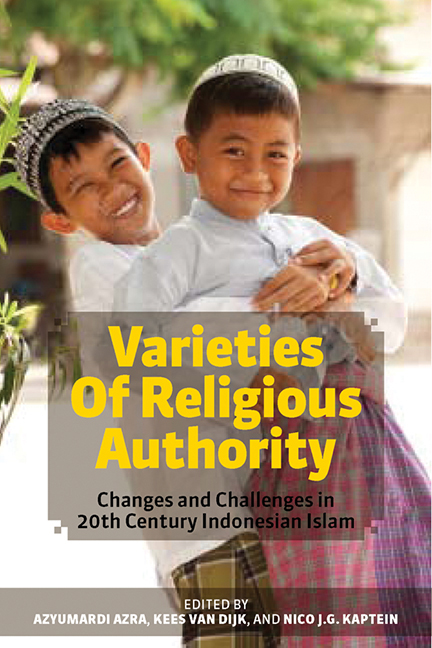Book contents
- Frontmatter
- Contents
- About the Contributors
- Acknowledgements
- Introduction
- 1 The Redefinition of Religious Authority among South Asian Muslims from 1919 to 1956
- 2 Understanding Al-Imam's Critique of Tariqa Sufism
- 3 Traditional Islam and Modernity: Some Notes on the Changing Role of the Ulama in Early Twentieth Indonesia
- 4 The Role and Identity of Religious Authorities in the Nation State: Egypt, Indonesia, and South Africa Compared
- 5 Authority Contested: Mathla'ul Anwar in the Last Years of the New Order
- 6 Struggle for Authority: Between Formal Religious Institution and Informal-local Leaders
- 7 The Indonesian Madrasah: Islamic Reform and Modernization of Indonesian Islam in the Twentieth Century
- 8 From Apolitical Quietism to Jihadist Activism: “Salafis”, Political Mobilization, and Drama of Jihad in Indonesia
- 9 From handling Water in a Glass to Coping with an Ocean: Shifts in Religious Authority in Indonesia
- 10 Religious Authority and the Supernatural
- Index
9 - From handling Water in a Glass to Coping with an Ocean: Shifts in Religious Authority in Indonesia
Published online by Cambridge University Press: 21 October 2015
- Frontmatter
- Contents
- About the Contributors
- Acknowledgements
- Introduction
- 1 The Redefinition of Religious Authority among South Asian Muslims from 1919 to 1956
- 2 Understanding Al-Imam's Critique of Tariqa Sufism
- 3 Traditional Islam and Modernity: Some Notes on the Changing Role of the Ulama in Early Twentieth Indonesia
- 4 The Role and Identity of Religious Authorities in the Nation State: Egypt, Indonesia, and South Africa Compared
- 5 Authority Contested: Mathla'ul Anwar in the Last Years of the New Order
- 6 Struggle for Authority: Between Formal Religious Institution and Informal-local Leaders
- 7 The Indonesian Madrasah: Islamic Reform and Modernization of Indonesian Islam in the Twentieth Century
- 8 From Apolitical Quietism to Jihadist Activism: “Salafis”, Political Mobilization, and Drama of Jihad in Indonesia
- 9 From handling Water in a Glass to Coping with an Ocean: Shifts in Religious Authority in Indonesia
- 10 Religious Authority and the Supernatural
- Index
Summary
Two major Muslim organizations, the so-called “traditionalist” Nahdlatul Ulama and “reformist” Muhammadiyah, are habitually said to dominate Indonesian Islam, and are thus presented as the religious pillars of the country's stability. To evaluate their influence, people tend to talk in numbers, and seem satisfied that one would have around 45 million “members”, as it claims, and the other 35 million “members” (whereas it would be more appropriate to speak of sympathizers). Beyond this simplistic presentation of religious authority in Indonesia, which implies that life is still what it used to be, processes of changes are at work.
This chapter tries to discern some stages of an undeniable evolution, starting in the early twentieth century and going on until today, based both on print material and, for a major part, on interviews with several ulama of the older generation, whom I visited during the course of my stay in Indonesia in 2005.
First, I will describe briefly the evolution of legitimacy within Javanese traditionalist Islam in the early twentieth century, the way this authority adapted to early challenges and historical events. The impact of Reformasi on traditionalist Islam is then observed, when politics were burdened with a highly religious content. Finally, emerging new religious authorities are described as well as the ulama's reaction to them.
Given the rising influence of radical Islamist literature available through translations on book markets and via Internet, the Javanese ulama are sought after as a natural counterweight to Middle Eastern influences. Expectations are high, but religious authority is far from monolithic within religious organizations. New actors do challenge traditional religious authority, but only a few Javanese ulama seemed troubled in 2005. This might be due to the fact that they faced incessant challenges before, but also because of their ambivalent judgement of the new generation.
A HISTORICAL PERSPECTIVE: KNOWLEDGE, THE REVOLUSI, THE CHILDREN
Religious authority has never been monolithic but it seems that modern means of communication have amplified competition.
- Type
- Chapter
- Information
- Varieties of Religious AuthorityChanges and Challenges in 20th Century Indonesian Islam, pp. 157 - 176Publisher: ISEAS–Yusof Ishak InstitutePrint publication year: 2010

